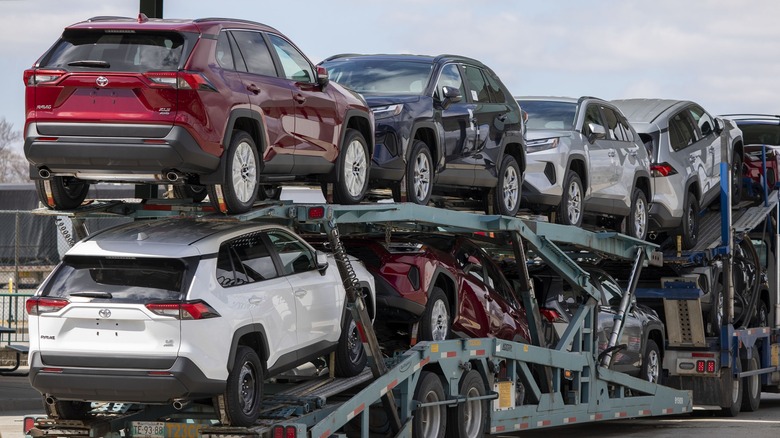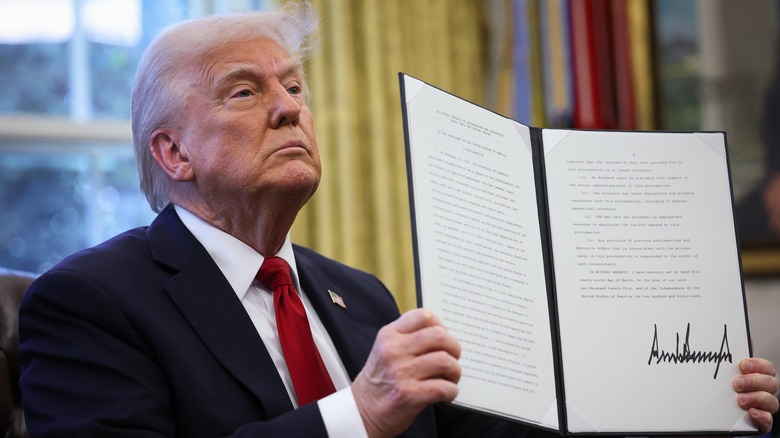Will Used Car Prices Go Up Under Trump's Tariffs? Here's What You Need To Know
As President Donald Trump settles into his second term, his administration's focus on tariffs has many Americans wondering about the potential impact on their everyday expenses, like tech gadgets, groceries, and other goods. However, among these larger concerns, the automotive market stands out as particularly vulnerable to policy changes. If you're considering purchasing a vehicle in the coming months, you might be wondering if the prices of the car brand you're considering might increase due to Trump's tariffs.
The automotive industry represents a complex global network of manufacturing, parts suppliers, and dealerships that react quickly to economic policy shifts. When tariffs enter this equation, the effects ripple throughout both new and used vehicle markets, often in ways that aren't immediately obvious to the average consumer. The connection between government trade policy and the price tag on that Subaru you've been eyeing might not seem straightforward at first. However, as we'll see, even policy decisions aimed primarily at new imports can substantially affect what you'll pay for a three-year-old domestic model. Let's get into the details of this economic relationship and what it means for your next vehicle purchase.
What's happening with Trump's tarrifs?
Since returning to office in January 2025, Trump has been implementing a series of tariffs as a cornerstone of his economic policy. Tariffs, simply put, are taxes placed on goods imported from other countries. When a 25% tariff is applied to a product, it means an additional 25% of that product's value must be paid to the U.S. government when that item enters the country.
The current tariff implementation follows a clear timeline of escalating trade measures, which involves a lot of politics we are not particularly concerned with for this article. Importantly, for the automotive sector, currently the most significant development is the 25% tariff on cars entering the United States, with a particular focus on cars made in Mexico, Canada and China. Additionally, a 25% tariff on imported car parts is scheduled to take effect in May or later. These automotive tariffs follow earlier measures, including a 25% tariff on all steel and aluminum imports from March 12, 2025, on, which may indirectly impact vehicle manufacturing costs.
Automakers warned in a letter sent to U.S. government officials that tariffs on car parts will "scramble the global automotive supply chain and set off a domino effect that will lead to higher auto prices for consumers," as well as to lower sales and increased costs for car repairs, among other things. It's worth noting that some flexibility exists within these policies. The administration has created certain exemptions, including a month-long tariff exemption for cars made in North America that comply with the continent's existing free trade agreement.
The ripple effect on used cars prices
When tariffs increase the cost of new vehicles, the effects cascade throughout the entire automotive market in predictable but significant ways. According to Investopedia data, we're already experiencing elevated car prices across the board, with average monthly payments having risen 26% for new vehicles and an even higher 30% for used vehicles over the past five years. The new tariff policy is poised to amplify this trend substantially.
The mechanism behind this effect is simple economics: supply and demand. As Jeremy Robb, senior director of economic and industry insights at Cox Automotive, told Investopedia: "Some consumers get priced out of new vehicles, and they have to trade down to used vehicles, which puts more pressure on the value of used vehicles." This shift creates increased demand for used cars precisely when supply may be constrained.
The mathematics of these price increases are concerning for budget-conscious shoppers. J.P. Morgan analysts estimated that the auto industry could see $82 billion in additional costs from these tariffs each year. Goldman Sachs provided even more specific projections for consumers: imported cars could see price hikes from $5,000 to $15,000 more, while domestic cars could see increases between $3,000 and $8,000.
The interconnected nature of vehicle markets means that policy changes targeting imported vehicles and parts will inevitably affect even those shopping for domestic, cheap, or reliable older models. As manufacturers and dealers adapt to these new economic realities, consumers across all automotive market segments will likely face higher prices for the foreseeable future.


